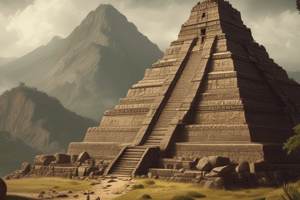Podcast
Questions and Answers
What was the role of architecture in the early expansion of the Inka Empire?
What was the role of architecture in the early expansion of the Inka Empire?
Architecture played a very limited role early on, but the Inka focused on creating ephemeral structures for warfare because their tents because they were easily transportable.
How did the Inka use textiles in their military expansion?
How did the Inka use textiles in their military expansion?
Textiles were crucial for creating easily transportable tent cities that accommodated varying numbers of soldiers.
In what time frame did the Inka Empire transform into the largest indigenous empire in the Americas?
In what time frame did the Inka Empire transform into the largest indigenous empire in the Americas?
The Inka Empire underwent this transformation in about 100 years from a small polity in the Cusco valley but as new data are accumulating, it is possible that the process took much longer.
What was the name of the primary road network used by the Inka?
What was the name of the primary road network used by the Inka?
How did the Inka transport stones to construction sites?
How did the Inka transport stones to construction sites?
What materials did the Inka use for dressing the stones?
What materials did the Inka use for dressing the stones?
Why was it important for the Inka masons to be precise when dressing stones?
Why was it important for the Inka masons to be precise when dressing stones?
What was one way the Inka controlled the movement of their subjects on these roads?
What was one way the Inka controlled the movement of their subjects on these roads?
How did the mobile tent cities of the Inka influence their permanent settlements?
How did the mobile tent cities of the Inka influence their permanent settlements?
What materials were commonly used in the construction of Inka buildings?
What materials were commonly used in the construction of Inka buildings?
Describe the characteristics of Inka adobe blocks.
Describe the characteristics of Inka adobe blocks.
What was the decorative practice for elite adobe buildings in Inka settlements?
What was the decorative practice for elite adobe buildings in Inka settlements?
What types of structures comprised Inka permanent settlements?
What types of structures comprised Inka permanent settlements?
What architectural form did the Inka primarily utilize as the foundation for their settlements?
What architectural form did the Inka primarily utilize as the foundation for their settlements?
How did the Inka adapt their architectural designs to accommodate different functions?
How did the Inka adapt their architectural designs to accommodate different functions?
Why was it important for the Inka to have a distinctive architectural design vocabulary?
Why was it important for the Inka to have a distinctive architectural design vocabulary?
What were the core elements of Inka architecture used to convey their architectural presence?
What were the core elements of Inka architecture used to convey their architectural presence?
What labor strategy did the Inka employ, and how did it influence their architectural construction?
What labor strategy did the Inka employ, and how did it influence their architectural construction?
What challenges did the Inka face in finding suitable land for construction in the Andes?
What challenges did the Inka face in finding suitable land for construction in the Andes?
How did the Inka manage water distribution for agriculture and households?
How did the Inka manage water distribution for agriculture and households?
Describe one architectural feature that is characteristic of Inka buildings.
Describe one architectural feature that is characteristic of Inka buildings.
What role did local cultural dynamics play in Inka architecture?
What role did local cultural dynamics play in Inka architecture?
How did the Inka's architectural style contribute to the survival of their buildings over centuries?
How did the Inka's architectural style contribute to the survival of their buildings over centuries?
What materials were primarily used in the construction of the ceremonial architecture of Chavín?
What materials were primarily used in the construction of the ceremonial architecture of Chavín?
Describe the function of the tennon heads incorporated into the architecture of Chavín.
Describe the function of the tennon heads incorporated into the architecture of Chavín.
What is the significance of the sunken court's circular design at the Chavín site?
What is the significance of the sunken court's circular design at the Chavín site?
How did the interior tunnels of the main ceremonial structure at Chavín reflect the architecture's purpose?
How did the interior tunnels of the main ceremonial structure at Chavín reflect the architecture's purpose?
What dual imagery is depicted in the stone slabs surrounding the sunken court at Chavín?
What dual imagery is depicted in the stone slabs surrounding the sunken court at Chavín?
How did the size of hammerstones affect the precision of stonework in Inka architecture?
How did the size of hammerstones affect the precision of stonework in Inka architecture?
What visible evidence allows us to understand the technique used by Inka masons in stoneworking?
What visible evidence allows us to understand the technique used by Inka masons in stoneworking?
Explain the significance of simultaneous working of stone blocks during Inka construction.
Explain the significance of simultaneous working of stone blocks during Inka construction.
What aspect of the hammerstone shape influenced the angles of the stones worked by Inka masons?
What aspect of the hammerstone shape influenced the angles of the stones worked by Inka masons?
Discuss the role of pressure in the stoneworking process compared to hammerstone size.
Discuss the role of pressure in the stoneworking process compared to hammerstone size.
Flashcards are hidden until you start studying
Study Notes
Inka Roads and Transportation
- Inka used existing and expanded roads for transporting people, armies and supplies
- Roads were a series of highways called Capac Ñan, as well as secondary and tertiary roads
- Stones used in construction were transported by groups of people pulling them with ropes
- Ramps were built to aid in moving stones down mountainsides using gravity
Inka Stoneworking
- Stones were "dressed" or carved to fit precisely
- Small hammerstones were used for precise carving
- River cobbles were often used as tools
Inka Ephemeral Architecture
- Early Inka architecture focused on mobile tent cities used for military purposes
- Textiles played a key role in constructing these ephemeral structures
- The design of these temporary settlements likely influenced the development of Inka permanent structures
Inka Building Materials
- Stone architecture:
- Fine mortarless masonry primarily used for elite structures
- Unworked and minimally worked masonry common for non-elite structures, often covered with stucco
- Adobe (sun-dried mud brick) was a popular building material
- Adobe blocks varied in size, often longer and thinner than Spanish-introduced blocks
- Adobe structures were frequently painted in bright colors like black, red, yellow, and white
Inka Architectural Features
- The rectangle was the basic building form, varied in size, proportions, and openings
- Inka architecture used a simple but flexible toolkit that was adaptable to different environments and purposes
- Seven core elements were used to distinguish Inka architecture:
- Single room, rectangular buildings
- Battered walls
- Trapezoidal features (windows, doorways, and niches)
- Gabled and hipped roofs
- Terraces
- Relationship to natural features
- Stone architecture: polygonal and ashlar masonry
- The Inka adapted local design and construction elements to create an Inka architecture that reflected local cultural dynamics and history.
Inka Engineering
- Inka were skilled engineers:
- Excavated and stabilized construction sites
- Built underground water channels
- Created terraces for agriculture and stable surfaces for buildings
- Inka structures are known for their resilience to earthquakes
The History of Stone Architectural Construction in the Andes
- Inka masons used different sizes of hammerstones to create precise and varied finishes on stone blocks.
- Larger hammerstones were used for the main faces of the stone blocks.
- Smaller hammerstones were used for the edges or corners of the stone blocks. The process of this shaping was done simultaneously as the blocks were placed into the walls.
- This process left visible scars on the stones, revealing the size of the tools used by the masons and their technique.
- The Inka viewed the landscape as sacred, particularly the materials like stone.
- They used architecture to articulate this understanding, such as framing vistas to sacred mountain peaks or carving sacred outcrops.
- The Inka architecture served as a visible symbol of their elite status and presence.
- The Inka built environment proclaimed their own entanglement with sacred status and power.
- The master masons at Chavín de Huántar used stone to make their majestic monument and depict intricate sacred images.
- Chavín de Huántar was a powerful pilgrimage center.
- The Tiwanaku were known for their advanced stone carving technology and process, rivaling some of the finest ever created.
- Their architecture influenced the Inka.
- The Inka developed their own distinctive tradition of stone carving, which was flexible, adaptable, and well-suited to their changing imperial desires.
- The architecture symbolized Inka beliefs, housed their state and domestic needs, and facilitated their development into the largest Native American empire in the history of the Americas.
- The study of Andean architecture is a relatively young field, and there is much that is still unknown about the diverse architectural styles and techniques used.
Specific Examples of Andean Architecture
- The Inka royal estate of Chinchero featured a polygonal Inka wall.
- Machu Picchu is known for its ashlar masonry and trapezoidal doorway.
- Chavín de Huántar featured massive stone tennon heads, projecting stone sculptures depicting human, animal, and other heads in varying states of transformation.
- Tiwanaku is known for its precise fine masonry.
- Inka walls are often battered (sloping).
- Trapezoidal niches are a feature of Inka buildings in Pisac.
- The cuysumanco was a rectangular structure associated with the Inka royal estate.
- The carpa uasi (house of the tent) was also associated with the Inka ruler.
The Threats to Andean Architecture
- Architectural traditions of the Americas are threatened by time and man.
- The destructive nature of cities expanding and architectural reconstruction for tourism negatively impacts the preservation of historical buildings.
The Importance of Andean Architecture
- Andean architecture represents a powerful visual record of the skills, beliefs, and cultural values of the ancient civilizations of the Andes.
- It is a constant reminder of the diversity and complexity of the human experience.
- Its preservation is vital to understanding the past and informing the future.
Studying That Suits You
Use AI to generate personalized quizzes and flashcards to suit your learning preferences.




